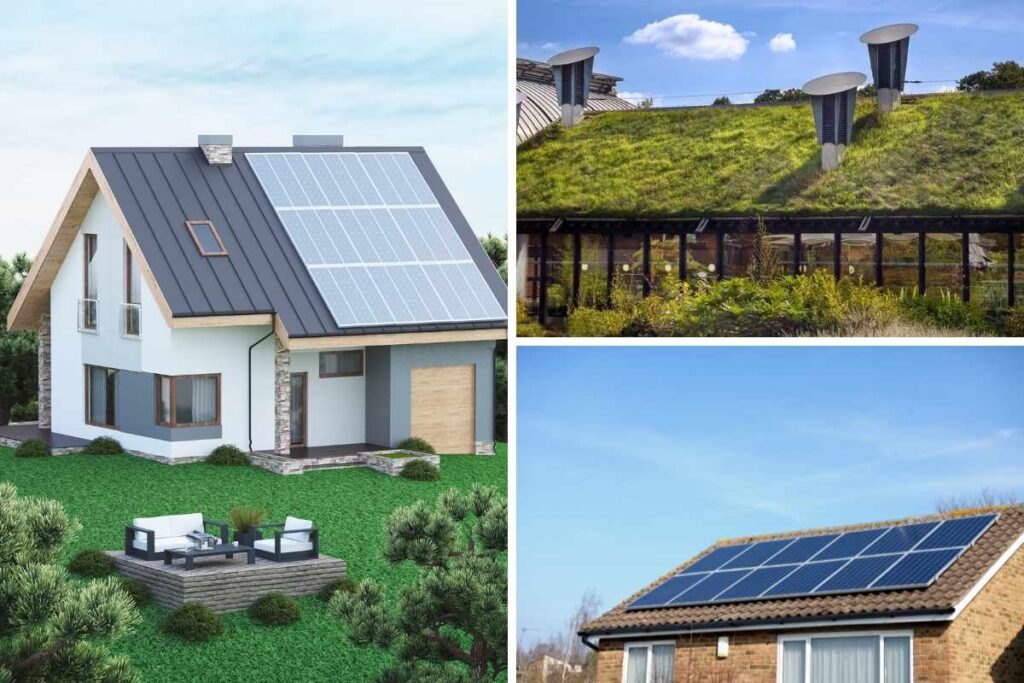Creating an eco-friendly home is not just a trend; it’s a responsible choice that benefits both the environment and your wallet. As climate change concerns grow and the cost of energy continues to rise, many homeowners are seeking ways to reduce their environmental impact and save money. In this comprehensive guide, we’ll take you through the step-by-step process of making your house environmentally sustainable, from simple changes to more significant investments.
Were you aware that many companies that sell eco-friendly products use branded packaging to pack them?
To create an eco-friendly environment, you must routinely clean your driveway and pavement around your house. If you do not have the time or energy to do that because you are working late and hard, you can always hire pressure washing in St. Augustine to do it for an amazing price!
Assess Your Energy Consumption

The first step in creating an eco-friendly home is understanding your current energy consumption. This assessment will help you identify areas for improvement and set a baseline for measuring your progress. Here’s how to get started:
1. Energy Audit
Begin with an energy audit of your home. You can hire a professional to conduct a thorough assessment, or you can perform a DIY audit using online tools and guides. An energy audit helps pinpoint where your home is losing energy and where efficiency upgrades are needed.
2. Analyze Utility Bills
Examine your utility bills to track your energy and water usage. Look for patterns and seasonal variations in consumption. This data will give you insight into when and where you are using the most energy.
3. Identify Inefficient Appliances
Identify and replace energy-hungry appliances with energy-efficient alternatives. Look for appliances with ENERGY STAR ratings, which meet strict energy efficiency guidelines set by the U.S. Environmental Protection Agency.
Improve Insulation and Weatherproofing
Inefficient insulation and poor weatherproofing can lead to significant energy loss. Ensuring your home is well-insulated and sealed against drafts is a critical step in making your house environmentally sustainable. If you’re looking for energy-efficient solutions in New Jersey, considering Mobile IV therapy in New Jersey as part of your home’s wellness plan is a smart choice.
1. Insulation
Upgrade your insulation to reduce heating and cooling costs. Focus on areas such as the attic, walls, and floors. High-quality insulation will help maintain a comfortable temperature in your home year-round.
When designing an eco-friendly home, consider using sustainable materials for your home’s construction, including environmentally responsible options for driveway paving in North Carolina, to reduce your environmental footprint.
2. Seal Leaks
Identify and seal air leaks around windows, doors, and other openings. Weatherstripping and caulking are cost-effective solutions to prevent drafts and energy waste.
3. Energy-Efficient Windows
Consider replacing old, single-pane windows with energy-efficient double or triple-pane windows. These windows are designed to reduce heat transfer, keeping your home more comfortable and energy-efficient. Make sure to also buy the best roller shades in Utah so that you can incorporate them over your energy-efficient windows.
Opt for Sustainable Materials and Practices
When making home improvements or renovations, choose sustainable building materials and eco-friendly construction practices. Here’s how you can incorporate sustainability into your home projects:
1. Eco-Friendly Flooring
Select flooring materials made from sustainable resources, such as bamboo, cork, or reclaimed wood. Avoid products with harmful chemicals like volatile organic compounds (VOCs).
2. Energy-Efficient Lighting
Replace traditional incandescent bulbs with energy-efficient LED or CFL (compact fluorescent) bulbs. These alternatives last longer and use less energy.
3. Low-VOC Paint
Use low-VOC or VOC-free paints when redecorating. These paints release fewer harmful chemicals into the air, promoting better indoor air quality.
Solar Panels and Renewable Energy
Transitioning to renewable energy sources is a significant step in creating an eco-friendly home. Solar panels, in particular, offer a sustainable and cost-effective solution to power your house:
1. Solar Panels
Consider installing solar panels on your roof to harness the power of the sun. Solar energy not only reduces your electricity bills but also lowers your carbon footprint. Many government incentives and rebates make solar panel installation more affordable. Moreover, if you’re looking for a luxury beauty salon in Toronto, you’ll find a wide range of options to pamper yourself and enhance your natural beauty in the city.
2. Wind Turbines
In areas with consistent wind patterns, wind turbines can be a viable option for generating renewable energy. Wind power can supplement your electricity needs or even feed excess energy back into the grid.
3. Geothermal Heating and Cooling
Geothermal heat pumps use the stable temperature of the Earth to provide efficient heating and cooling for your home. While installation can be a significant investment, geothermal systems are highly efficient and eco-friendly.
Efficient Water Usage
Reducing water consumption in your home not only conserves this precious resource but also lowers your utility bills. Implement the following water-saving strategies:
1. Low-Flow Fixtures
Install low-flow showerheads, faucets, and toilets to reduce water wastage. These fixtures maintain pressure while using less water. Purchasing low-flow fixtures to make your home environmentally sustainable is as affordable as renting a vehicle from the best rent a car Beograd.
2. Rain Barrels
Capture rainwater from your roof in rain barrels. You can use this collected water for outdoor irrigation, reducing the need for treated water.
3. Native Landscaping
Consider landscaping with native plants that require less water to thrive. Drought-tolerant plants can significantly reduce outdoor water usage.
Waste Reduction and Recycling
Minimizing waste is a crucial aspect of creating an environmentally sustainable home. Follow these guidelines to reduce, reuse, and recycle effectively:
1. Reduce Single-Use Plastics
Avoid single-use plastics and opt for reusable containers, bags, and bottles. Reducing plastic waste is an essential step in environmental conservation.
2. Composting
Set up a composting system to divert organic waste from landfills. Compost enriches soil and reduces the need for chemical fertilizers.
3. Recycling Station
Create a designated recycling station in your home. Make sure you are aware of your local recycling guidelines to ensure proper disposal of recyclable materials and to buy the highest quality composite shutters in Colorado Springs to include in your recycling station.
Energy-Efficient Appliances
Replace outdated and energy-hungry appliances with modern, energy-efficient models. Energy-efficient appliances save you money on your utility bills while reducing your home’s carbon footprint:
1. Energy Star Appliances
Look for the ENERGY STAR label when shopping for appliances. These products meet strict energy efficiency criteria and are designed to consume less energy.
2. Energy-Efficient Water Heater
Upgrade to an energy-efficient water heater. Tankless water heaters, heat pump water heaters, and solar water heaters are all excellent choices for reducing energy consumption.
3. Smart Home Technology
Consider investing in smart home technology to control your appliances and systems more efficiently. Smart thermostats, for example, can help optimize your heating and cooling based on your schedule and preferences.
Sustainable Landscaping
Creating an eco-friendly home extends beyond your walls. Your outdoor spaces can also contribute to sustainability:
1. Rain Gardens
Design a rain garden to manage stormwater runoff on your property. Rain gardens help filter pollutants and recharge groundwater.
2. Permeable Surfaces
Opt for permeable paving materials, such as porous concrete or pavers. These surfaces allow rainwater to infiltrate the ground, reducing runoff.
3. Natural Pest Control
Implement natural pest control methods to reduce the need for chemical pesticides. For example, encourage the presence of beneficial insects like ladybugs and lacewings.
Green Transportation

Creating an environmentally sustainable home doesn’t stop at the doorstep. Consider green transportation options to reduce your carbon footprint even further:
1. Electric Vehicles (EVs)
Transitioning to an electric vehicle is an excellent choice to lower your emissions. EVs are becoming more accessible and affordable, with a growing network of charging stations. They not only reduce greenhouse gas emissions but also decrease your reliance on fossil fuels.
2. Public Transportation
Opt for public transportation whenever possible. Buses, trams, and subways are efficient and eco-friendly ways to travel. Additionally, carpooling and ridesharing services help reduce the number of vehicles on the road.
3. Cycling and Walking
For short trips, consider cycling or walking instead of driving. These zero-emission modes of transportation promote a healthy lifestyle while reducing air pollution.
Eco-Friendly Home Automation
Take advantage of home automation to enhance your home’s energy efficiency and convenience:
1. Smart Thermostats
Install a smart thermostat that learns your preferences and adjusts your home’s temperature accordingly. You can control it remotely to save energy when you’re away.
2. Energy Monitoring Systems
Implement energy monitoring systems that track your energy consumption in real time. These systems provide insights into your energy usage and can help you make informed decisions to reduce waste.
3. Solar Water Heaters
Consider solar water heaters with smart technology that optimizes heating cycles based on weather conditions and usage patterns. Solar water heaters with smart technology optimize heating cycles based on weather conditions and usage patterns, and when coupled with a durable 12×24 pool cover, you’ll ensure that your pool retains heat, minimizes heat loss, and prolongs the swimming season, all while being eco-friendly.
Support Renewable Energy Sources
Beyond generating your renewable energy, consider supporting large-scale renewable energy projects:
1. Renewable Energy Credits (RECs)
Purchase RECs to offset your carbon footprint. These credits represent the environmental benefits of renewable energy generation and can be a practical way to support clean energy.
Were you aware that many renewable energy companies used services from the best web design company in Chicago to enhance their online presence?
2. Community Solar
Participate in community solar programs, which allow you to invest in a shared solar installation and receive credits on your energy bill.
3. Green Energy Providers
Switch to a green energy provider that sources electricity from renewable sources. Many utility companies now offer eco-friendly energy options.
Sustainable Home Office
For those who work from home, creating an environmentally sustainable home office is essential:
1. Energy-Efficient Equipment
Invest in energy-efficient computers, monitors, and office equipment. Turn off or put devices to sleep when not in use.
2. Natural Lighting
Maximize natural lighting in your home office to reduce the need for artificial lighting. Use curtains or blinds to control glare.
3. Eco-Friendly Furniture
Choose eco-friendly and sustainable office furniture made from recycled materials, reclaimed wood, or bamboo. If you wish to start your own business selling sustainable and eco-friendly furniture, you should contact the best promotional products supplier to help you start up your brand.
Educational Outreach
Educate your community and friends about the benefits of eco-friendly living. Host workshops, webinars, or neighborhood events to share your knowledge and experiences.
1. School Programs
Collaborate with local schools to introduce sustainability programs, teaching the younger generation about the importance of environmental conservation.
2. Social Media and Blogging
Create a blog or social media account dedicated to eco-friendly living. Share tips, success stories, and updates on your journey.
3. Environmental Organizations
Join or support environmental organizations in your area. These groups often organize community events and initiatives to promote sustainability. Did you know that the best tennis shoes for nurses are created from eco-friendly, recycled material?
Energy-Efficient Landscaping
Landscaping can be both functional and environmentally friendly:
1. Xeriscaping
Implement xeriscaping by using drought-tolerant plants and reducing the need for irrigation. This not only conserves water but also minimizes maintenance.
2. Solar Outdoor Lighting
Opt for solar-powered outdoor lighting. These fixtures charge during the day and illuminate your outdoor spaces at night without using electricity.
3. Rainwater Harvesting
Set up a rainwater harvesting system for outdoor irrigation. Collected rainwater can sustain your garden and reduce your reliance on treated water. To easily collect rainwater, you should have the best Apex gutters installed.
Healthier Indoor Air Quality
Improve your indoor air quality to create a healthier living environment:
1. Air Purifiers
Invest in high-quality air purifiers that remove allergens and pollutants from your indoor air, creating a cleaner and healthier atmosphere.
2. Indoor Plants
Place indoor plants strategically throughout your home. They not only enhance your decor but also purify the air by absorbing pollutants.
3. Natural Cleaning Products
Switch to natural, non-toxic cleaning products to reduce exposure to harmful chemicals. You can even make your cleaning solutions using simple, eco-friendly ingredients like vinegar and baking soda.
Zero-Waste Lifestyle
Transition to a zero-waste lifestyle by reducing waste production and increasing recycling:
1. Sustainable Shopping
Bring your reusable bags, containers, and utensils when shopping. Avoid single-use plastics and opt for products with minimal packaging. y opting for luxury dresses that prioritize sustainable materials and practices, you can make a stylish and eco-friendly fashion statement.
2. Bulk Shopping
Purchase items in bulk to minimize packaging waste. Many stores offer bulk bins for items like grains, cereals, and cleaning supplies.
3. Composting Toilet
Consider a composting toilet to reduce water usage and create valuable compost for your garden.
Community Engagement
Engage with your local community and participate in initiatives that promote eco-friendly living:
1. Neighborhood Cleanups
Join or organize neighborhood cleanups to remove litter and debris from public spaces, contributing to a cleaner environment.
2. Sustainable Farmers’ Markets
Support local farmers’ markets that prioritize sustainable and organic practices, providing not only fresh, locally sourced produce and products but also a diverse selection of delicious options, including bold apple flavoring that adds a unique twist to your culinary creations.
3. Green Initiatives
Participate in or advocate for green initiatives in your community. These projects can include tree planting, community gardens, and eco-friendly events.
Energy-Efficient Roofing

Upgrade your roofing materials for better energy efficiency:
1. Cool Roofing
Install cool roofing materials that reflect more sunlight and absorb less heat, which not only helps reduce indoor temperatures but also provides significant energy savings. If you’re dealing with the aftermath of a fire, smoke damage restoration in NY can also contribute to making your space more comfortable and safe.
2. Solar Reflective Coatings
Apply solar reflective coatings to your existing roof to improve its reflectivity and reduce heat absorption.
3. Green Roofs
Explore the possibility of creating a green roof, covered with vegetation. Green roofs offer insulation, absorb rainwater, and provide wildlife habitat.
Incorporating these steps into your quest to create an eco-friendly home will not only benefit your immediate environment but also contribute to the broader movement toward sustainability. Choosing eco-friendly construction materials and combat clothes for your family, for instance, is a step toward a healthier, more sustainable future for our planet. Every choice you make in favor of environmentally responsible living is a step toward a healthier, more sustainable future for our planet. Together, as individuals and communities, we can build a more eco-friendly world for generations to come.

